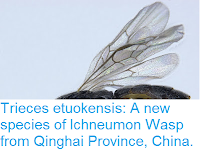Ichneumons are a widespread, numerous and diverse group of Wasps noted for their parasitoid reproductive strategy, which involves the adult female Wasp injecting an egg into a living host, with the emerging larva eating this host alive from the inside. Each species of Ichneumon Wasp typically targets a single host species, with the most common victims being Beetles, Butterflies, Spiders and other Wasps (including other Ichneumons). The genus Nesolinoceras contains a single species, Nesolinoceras ornatipennis, from Cuba, which targets the larvae of the Citrus-borer Beetle, Elaphidion cayamae, the female wasp drilling her ovipositor through the bark of the tree to lay her eggs on Beetle Grubs beneath.
In a paper published in the American Museum Novitates on 11 May 2016, Bernardo Santos of the Division of Invertebrate Zoology and Richard Gilder Graduate School at the American Museum of Natural History, describes a second species of Nesolinoceras from the Dominican Republic.
The new species is named Nesolinoceras laluzbrillante, where 'laluzbrillante' derives from the Spanish 'la luz brillante' meaning 'the bright light', in reference to the bright climate of the Dominican Republic and the glossy wings of the Wasp; this name having been chosen by students of the Washington Heights Expeditionary Learning School, in New York City. The species is described from five specimens, two females and three males, trapped in a recently cleared forest margin at the Punta Cana Ecological Foundation. These have a distinct black-and white colouration, and the females are slightly larger than the males, having a forewing length of 8.8-9.0 mm, while the forewing of the males measures 7.2-8.0 mm. The life-cycle of the species and host of the young is unknown.
See also...
Nesolinoceras laluzbrillante, female specimen. Santos (2016).
See also...
Follow Sciency Thoughts on Facebook.







